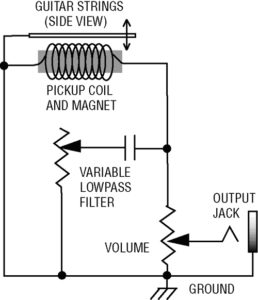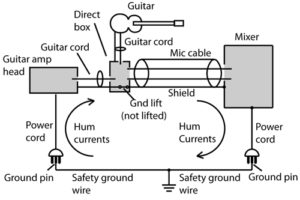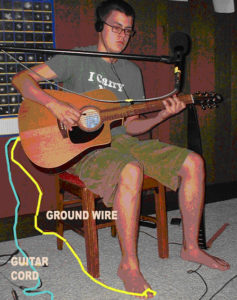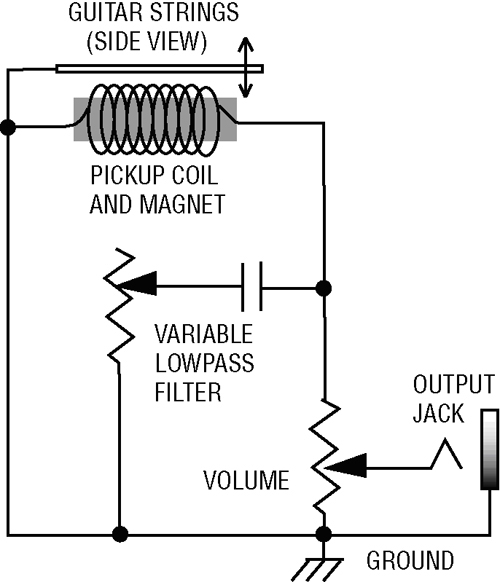You’re recording an electric guitar, or amplifying it through a P.A., and there it is: hum! This annoying sound is a common occurrence. Acoustic guitars fitted with pickups can have the same problem.
Hum is an unwanted 60 Hz tone — 50 Hz outside the U.S. — plus harmonics. If the harmonics are especially strong, the hum becomes an edgy buzz.
Let’s take a look at what’s going on and how to fix it. First we need to review how an electric guitar works.
Inside The Electric Guitar
Built into the guitar, under the strings, is a magnetic pickup: a transducer that converts the strings’ vibration into an electrical signal. The pickup is a bar magnet wrapped with thousands of turns of wire, forming a coil.
When the player plucks the steel strings, they vibrate next to the magnet, producing a similar vibration in the magnet’s magnetic field, which in turn causes a varying current in the coil.
Another type of pickup uses a separate magnet under each string. Some pickups have a screw on each magnet’s polepiece to adjust the distance between the polepiece and string, allowing level control of each string.
A humbucking pickup uses two coils wired in series but with opposite polarity so that they cancel common hum fields. One coil is mounted far from the strings. The high-impedance signal from the pickup coil goes through a simple circuit (Figure 1) and comes out the unbalanced guitar jack.

Components in the circuit are usually connected by single wires. The sleeve (ground) terminal on the jack is connected to the pickup coil, the strings, and the shield around the circuit. From the guitar jack, the signal travels through a guitar cord: an unbalanced shielded cable.
At the end of the cable, the signal can go to several destinations: a direct box, a guitar amp, a mixer’s high-Z input, or guitar stomp boxes/processors.
Most acoustic-guitar pickups are piezoelectric types installed under the bridge or saddle. Vibrations of the guitar body flex the pickup, which generates an electrical signal. It’s very high impedance, and often is run through a preamp built into the guitar which reduces the impedance.
Whether the guitar is electric or acoustic, any component in the signal chain is susceptible to picking up hum and buzz, especially because the entire circuit is high-impedance unbalanced.
Hum Sources
Alternating current in a building’s power wiring generates electric and magnetic fields that oscillate at 60 Hz and its harmonics. Hum fields also radiate from lighting circuits and fluorescent lights. The magnetic fields couple inductively to the guitar wiring. When the magnetic lines of force cut the conductors in the guitar and its pickup, the conductors generate a 60 Hz signal, which is amplified by the mixer or guitar amp.
Also, the power wiring and pickup act as two plates of a capacitor. The varying electric fields from the power wiring couple capacitively to the pickup and guitar wiring.
Another hum source is radio-frequency fields from computers, motors, and TV transmitters (vertical sync, blanking and vertical component video). This RFI can be detected by the guitar or audio equipment.
A major cause of hum is the ground loop. It is the circuit loop that is formed when two pieces of audio gear are connected to each other through a cable shield and also through the AC safety ground. If the two chassis are at different ground potential, a 60 Hz current can flow on the cable shield connecting them, causing audible hum.

Figure 2 shows a ground loop. Two equipment chassis (guitar amp and mixer) are connected to two separate safety grounds by their AC cords. Also, the equipment chassis are connected together by the shield of the audio cable coming from the direct box. The shield and safety-ground wires form a ground loop.
Causes & Cures
Let’s look at several examples of causes and cures of hum related to electric guitars.
Magnetic Hum Fields: As noted, AC in a room’s power wiring generates electric and magnetic fields that oscillate at 60 Hz and its harmonics. When the magnetic lines of force cut the conductors in the guitar and its pickup, the conductors generate a 60 Hz signal, which is amplified by the mixer or guitar amp.
Cure: The amount of hum generated depends on the angle between the pickup coil wires and the magnetic hum field. At certain angles, a lot of the hum goes away. So the player can rotate or move around to find a spot with minimum hum.
Electric Hum Fields: The power wiring and pickup act as two plates of a capacitor. The varying electric fields from the power wiring couple capacitively to the pickup and guitar wiring.
Cure: A grounded Faraday shield. In the guitar body are cutouts that house the electronics, wiring and pickups. These cutouts should be lined with conductive foil (such as copper foil) that is soldered together to form one continuous piece. This shield must be connected to the guitar jack’s ground terminal so that the hum fields are bypassed to ground (ideally, to the mixer chassis).
The guitar cord should also be well shielded. Use only high-quality cords with plugs having a metal jacket, which acts as a shield to the wires inside it.
Some guitar amps are painted on the inside with conductive paint that acts as a shield, but this paint coating can crack when the amp cabinet is jostled, breaking the shield connection. It’s best to run a ground strap between all panels of the amp head cabinet.
RFI (Radio Frequency Interference): A strong TV signal can be rectified and demodulated by some electronic components or a bad solder joint.
Cure: This is a subject in itself (see the references at the end of this article). But for a quick fix, install ferrite beads and .001 microfarad capacitors on mic inputs. Install RFI chokes on guitar cords or mic cables. Check solder joints.
Ground Loop: Suppose you’re recording a guitar direct, and the guitar is plugged into a guitar amp. The amp and your mixer have 3-prong power cords that connect to the safety ground. The amp is plugged into an AC outlet across the room, and your mixer is plugged into a nearby outlet. When you connect the amp ground to your mixer ground through the mic-cable shield, and monitor the signal, you hear hum.
Chances are that the outlets are fed from different circuit breakers, so the outlets are at different ground voltages. When you plug your amp and mixer into these separated outlets, and connect the equipment together with a mic cable from a direct box, the difference in ground voltages can make a 60-Hz hum current flow between the guitar amp and mixer. That’s a ground loop.
Cure: Flip the ground-lift switch on the direct box to break the loop. Also, it’s a good idea to power the mixer and guitar amp off the same outlet strip. That way, the ground voltage for all the equipment is about the same, so little or no hum current can flow between their chassis. Run a thick extension cord from the mixer’s outlet strip to the guitar amp, and plug the amp into the extension cord.
There still may be a slight voltage difference between components because their power supplies reflect different voltages onto their chassis. A balanced AC power supply can eliminate this problem. Before you plug in all those power cords, make sure that the sum of the equipment fuse ratings does not exceed the amperage rating for that circuit. In most cases, a single 20-amp breaker will handle a small studio.
Guitar Not Grounded: Suppose you’re recording a guitar with a direct box, and the guitar is NOT plugged into a guitar amp. If the ground is lifted on the direct box, the guitar is not grounded, so you hear a loud buzz.

Or if the shield connection is broken in the guitar cord or mic cable, the guitar is not grounded.
Cure: Flip the ground-lift switch to the grounded position when not using a guitar amp. Check inside the cable connectors to make sure the shield is soldered at both ends. Replace or repair guitar cords that have broken shields.
Player’s Body Not Grounded: When the guitar player touches the strings, does the hum stop? This indicates that the player’s body is acting as one plate of a capacitor.
The capacitance between the body and power wiring adds to the capacitance between the guitar and power wiring, increasing the level of the hum transmitted from the power wiring to the guitar. (Incidentally, the same thing happens if you replace the player’s body with a sheet of aluminum foil).
Cure: Run a wire between a ground point on the guitar and the player’s skin. Figure 3 shows a ground wire (highlighted in yellow) between the guitar-jack ground and the player’s big toe! This grounds the player’s body, so that it acts as a partial shield for the guitar, rather than a capacitor.
Note: For a technical discussion of body grounding, please see the sidebar at right.
A body close to the guitar increases hum, and connecting the body to the guitar ground stops the hum. The body is not a ground for the guitar. Rather, the guitar ground is a ground for the body.
So now we know why some heavy-metal guitarists play without a shirt. They’re removing the dielectric between their skin and the guitar. (Thanks to Chris Vice of Crown for that insight).
Caution
Do NOT use this ground wire in a concert situation if the guitar is plugged into a guitar amp. There might be a shock hazard if the player touches a mic. That can happen if the mic, which is grounded to the FOH mixer, is at a different ground potential than the guitar amp onstage.
To reduce the potential between mixer and guitar amp, power the mixer through a thick extension cord plugged into the AC distro outlet that the guitar amp is plugged into.In other words, do NOT make a permanent connection between the player’s skin and the guitar ground in this situation. You might ask the player to keep their hands on the strings whenever possible.
Shock Hazard
This is not about hum, but is an important related issue. In concerts, electric-guitar players can receive a shock when they touch their guitar strings and a mic simultaneously. This occurs when the guitar amp is plugged into an electrical outlet on stage, and the mixing console (to which the mics are grounded) is plugged into a separate outlet across the room.
As previously stated, these two power points may be at widely different ground voltages, so a current can flow between the grounded mic housing and the player touching the grounded guitar strings.
Electric guitar shock is especially dangerous when the guitar amp and the console are on different phases of the AC mains.
The cure is to power all instrument amps and audio gear from the same AC distribution outlets. That is, run a heavy extension cord from a stage outlet back to the mixing console (or vice versa).
Plug all the power-cord ground pins into grounded outlets. That way, you prevent shocks and hum at the same time.
Using a neon tester or voltmeter, measure the voltage between the electric-guitar strings and the metal grille of the microphones.
If there is a voltage, flip the polarity switch on the amp. Use foam windscreens for additional protection against shocks.
Quick Tips
When you hear hum or buzz from an electric guitar, try these solutions:
- Turn up the guitar’s volume and treble controls so that the guitar signal overrides hum and noise picked up by the guitar cable and guitar amp.
- Ask the guitarist to move around, or rotate, to find a spot in the room where hum disappears.
- Flip the polarity switch on the guitar amp to the lowest-hum position.
- To remove buzzes between guitar notes, try a noise gate.
- If the hum stops when the player touches the guitar strings, ask the player to keep his or her hands on the strings, or run a wire between the player’s skin and a ground point on the guitar (such as the strings or the jack ground.)
- Set the direct-box ground lift switch to the position where you monitor the least hum.
- Replace or repair guitar cords that have broken shields. Use only high-quality cords with metal-jacket plugs.
- Power the guitar amp off the mixer’s outlet strip.
- Use guitars with humbucking pickups, or install modern humbuckers in older guitars.
- Line cutouts in the guitar body with copper foil wired to the guitar jack ground.
- If you suspect RFI, install ferrite beads, capacitors and chokes. Also see the references below.
- Replace any defective tubes in the guitar amp. If the power-supply filter capacitors in the guitar amp are corroded, replace them. This replacement should be done by an authorized technician.
- Use a quieter amplifier.
- Don’t use a noisy amp. Instead, record the guitar direct, then process its track with a guitar-amp modeling plug-in or processor.
- Don’t use SCR lighting dimmers because they add noise and hash to the AC power. Instead, use multiway incandescent bulbs to vary the studio lighting levels. If you must use a SCR dimmer, rotate its knob to find a position with the least hum (maybe the “off” position!).
- Run the studio off its own breaker, not shared with noisy loads such as air conditioning, power tools, etc. Don’t ground the neutral at more than one point (have an electrician check this). Use an AC line isolation transformer between the AC power and the studio equipment.
If you follow these suggestions, the only buzz you get should be from the guitar player’s solo!
Good luck.
Acknowledgement: Many thanks to these SynAudCon members for their helpful discussions: Jim Brown, Rick Kamlet, Bob Hagenbach, Mike Miles, Pat Brown, Steve Roth, and Peter Patrick.















